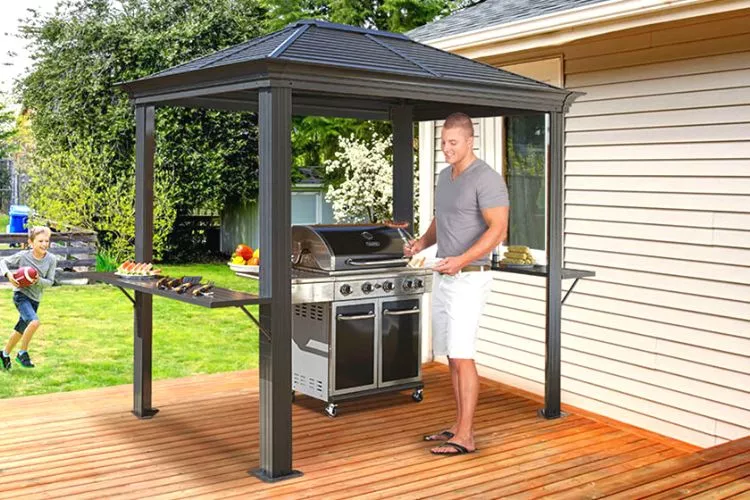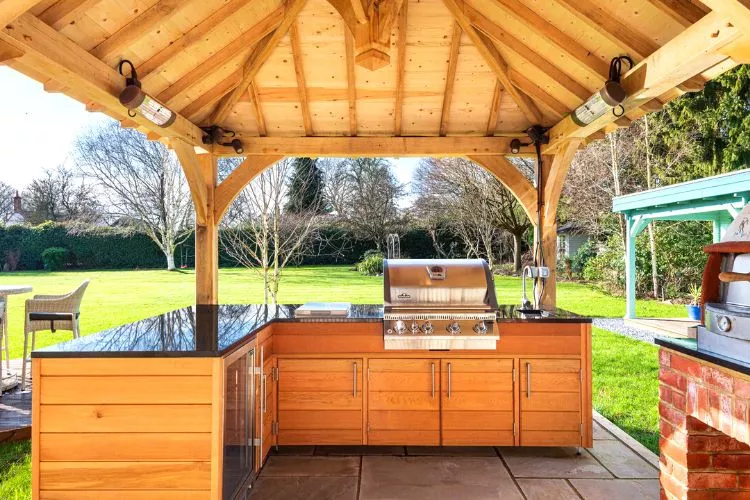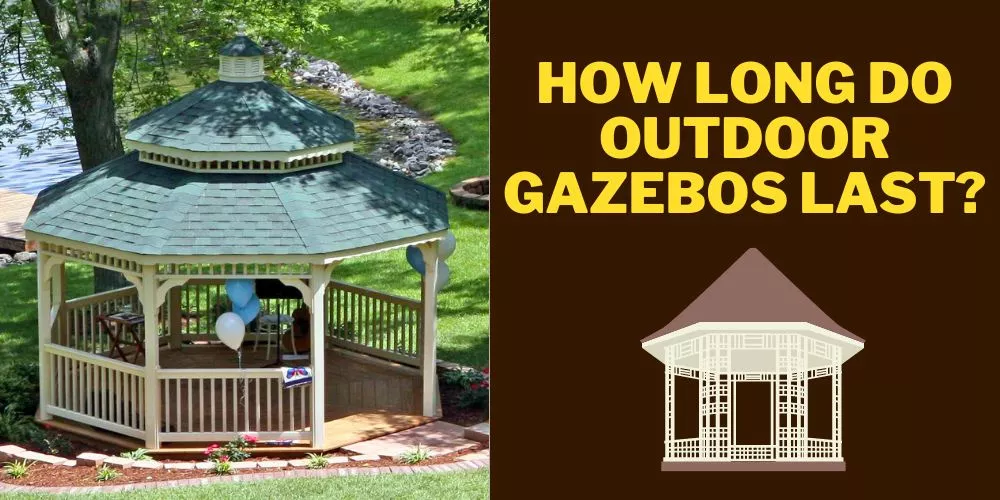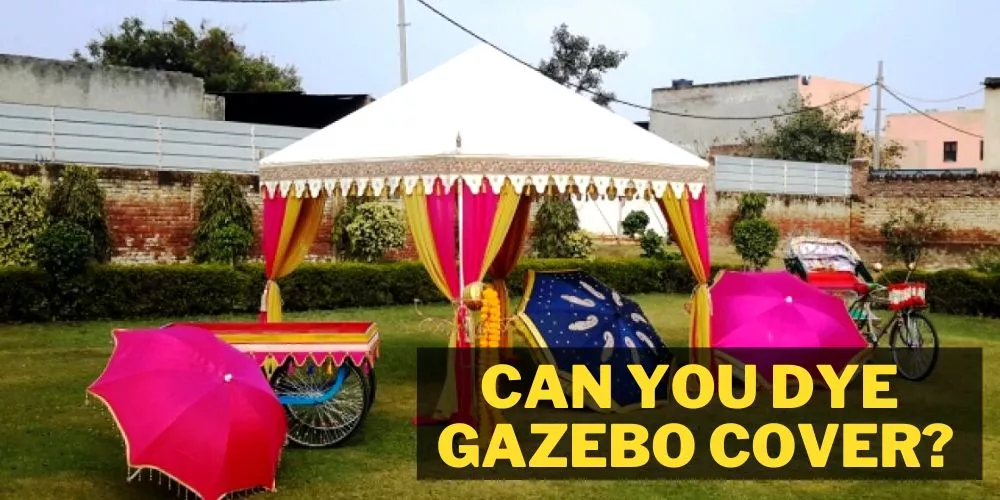The concept of a gazebo is to allow its user to enjoy a moment of peace and be sheltered from the varying weather elements. Quite often, these outdoor activities that use a gazebo usually involve some kind of food, mainly in the form of a BBQ.

Can you grill under a gazebo? Is it safe? Will your gazebo catch on fire? Are there other types of gazebos that have built in grill areas? What other risks are there? In this article, we’ll go into extensive detail surrounding these questions.
Can you grill under a gazebo?
In short, yes, you can grill under a gazebo. However, doing so is not recommended. Many safety hazards can harm you, your guests, or even your gazebo. The main concerns are adequate airflow and excess temperatures. All BBQs require ventilation to help circulate smoke, gas, ash, etc. A gazebo’s smaller, more intimate, and often cramped nature can generally not circulate air efficiently.
Moreover, most gazebo structures have a roof and even walls that can be made from combustible materials. This makes them susceptible to melting and burning via wayward sparks or flames. However, some gazebo models can be much larger, avoid overheating, and allow adequate airflow. Even though it seems like the only option, it may not be the best.
Can Grill Gazebos be a Solution?
Grill gazebos can be a solution, as they are specifically designed to allow the user to do so. They are undercover grilling stations which are often smaller than an actual gazebo. Their purpose is mainly for grilling but with the added luxury of built-in benches or other kitchen elements which assist with food preparations.
A grill gazebo could indeed be an excellent solution for someone looking to grill, irrespective of weather or environmental conditions. Here are a few reasons why:
Protection from Weather: Grill gazebos generally have a hard or fabric top, which can protect you from rain, sunlight, sudden wind, or other unexpected weather conditions all year round, enabling you to enjoy your barbecue without any worries.
Safety Features: Grill gazebos are specifically designed with grilling in mind. They usually have better ventilation than standard gazebos, reducing the risk of smoke accumulation and making it safer for you to grill.
Convenience: Many grill gazebos come equipped with various accessories or features aimed at making your grilling experience more convenient, such as built-in shelves for your grilling tools, condiments, hook for hanging grill utensils, even built-in bottle openers.
Aesthetic Appeal: Lastly, grill gazebos can be an attractive addition to your backyard or patio, and may even increase the value of your home by enhancing its appeal.
However, ensure proper safety while grilling under a gazebo. Make sure it is well-ventilated and install a fire extinguisher nearby for safety in case of a fire mishap. It’s also important to ensure that the grill is not set too close to the gazebo walls to prevent any accidental fires. Use grill gazebos responsibly and they can provide a great, sheltered cooking environment.

Safety Measures to Follow
If you are desperate to use your grill under a gazebo, then there are some important safety guidelines that you should try to follow. It’s quite easy to disregard safety when we just want to do our thing in these outdoor kitchen environments, but one wrong move can easily end in disaster. Here are some simple guidelines that can help ensure your grilling experience stays safe from unwanted accidents.

1. Grill Placement
Placing your grill somewhere at least 10 ft (3 m) in diameter of clearance is optimal. This ensures small projectiles such as flames, sparks, and wayward charcoal pieces can land and be dealt with before burning anything up.
If tighter spaces are the only option, then try to allow at least 20 inches (50 cm) behind the grill, 7 inches (18 cm) on each side, and 24 inches (61 cm) if the bbq is close to a vinyl wall of the gazebo. The ideal spot for a bbq should be on the outside of the gazebo to save any problems at all.
2. Height Of Gazebo
The height of the actual gazebo is not so important, but the clearance above the bbq is. In general, allowing at least 60 inches (1.5 m) of clearance above the bbq allows adequate ventilation and heat dispersion space. Furthermore, an exhaust hood must be used if the bbq is placed under any combustible material.
3. Proper Ventilation
Proper ventilation allows the smoke, charcoal fumes, gas, etc., to be adequately dispersed. These toxic fumes can be deadly in just a few minutes of hovering over them while cooking away. Make sure to keep all walls or side areas open. Additionally, try not to have too many people gathered around while cooking. This may not allow the air to circulate as effectively as it should.
4. Floor Material
Anything that can catch on fire is considered a safety risk. If possible, it’s best to grill on gravel, sand, rock, asphalt, or concrete if possible. They may become warm in the process, but they won’t allow wayward sparks to cause major damage. Avoid grilling on dry grasses or other organic materials such as leaves or tree branches. Plastic, wood, vinyl, and other flammable material should be moved well away before starting any grill session.
5. Have a Fire extinguisher
Fire extinguishers are a must. They may seem like something you’d only use in a worst case scenario, but you’d be surprised how quickly a fire can catch on. The best type for a bbq fire is a dry powder fire extinguisher. They can be used on gas, oils, and other flammable liquids. They work by smothering the fire and removing any remaining oxygen.
6. Keep The Kids Away
It’s impossible to put all kids in this category, but most don’t have that spatial awareness. They usually just want to hop around and play and don’t realize the severity of the materials in a bbq. Even touching the grill’s hot outer areas can cause serious injury. Furthermore, spitting oils and wayward embers or sparks can also cause bodily harm.
7. Never Leave the grill unattended
It’s easy to quickly run away to grab another ingredient or something of that nature and leave the bbq unmanned. Those couple of seconds or minutes can be disastrous, though. All it takes is some hot spitting oil to burn into plastic or flying sparks to catch onto some leaves, and the result can cause serious harm not only to your gazebo or home but also to anyone in the area, including pets.
8. Do Not Use Cheap Grills
Cheap grills are generally cheap for a reason. We don’t mean cheaper grills but the cheapest of the cheap. The materials are usually of poorer quality than those more expensive variants. Meaning they can become damaged or malfunction much more easily. This can lead to various dangerous situations, such as fires, heavy smoke, etc. Anything mid range and upward usually suffice when it comes to safety.
9. Avoid too much heat
Depending on the type of grilling you are doing, most processes don’t require maximum heat. If this is the case, it’s recommended to only use the heat required. This will help to reduce the risk of burning or melting anything in the vicinity, including our gazebo. Furthermore, when the mercury of your grill rises, it may be worth only standing close to it over small periods.
10. Avoid using a Charcoal Grill
Charcoal grills are amazing when it comes to the overall flavor of food. The issue with them is the sparks and flames which they can produce. Furthermore, they tend to let off a lot of smoke as they begin to generate heat. These sparks and flames can easily catch on to a wood, plastic, or vinyl gazebo, which can melt or burn them super fast. Smoke is also something that can cause grave health issues if a lot is inhaled.
Especially if the ventilation of the gazebo is poor. Electric and gas tend to be safer when controlling heat and smoke. At the same time, charcoal takes a lot more skill to control.
11. Use a Grill Pad
Grill pads are generally a new concept. They are essentially non-stick, heat resistant pads made from fiberglass. They are laid down on the grilling surface, and the food cooks on top of it. They can help to prevent any oils from splattering all over the place. All it takes is a few drops of hot oil to burn holes in your vinyl gazebo. It’s not an all-purpose solution, but it can help reduce the risk of unwanted accidents.
Do You Need Any Clearance to Grill Under a Gazebo?
Yes, clearance is necessary when grilling under a gazebo or any type of overhead structure. This is primarily due to safety reasons as well as the ease of grilling.
1. Safety
Grilling involves fire, and as we know, heat rises. If you have insufficient clearance above the grill, you risk the gazebo catching fire. Synthetic canopies or wooden roofs are especially susceptible. Therefore, several key considerations exist with regards to height clearance when installing a grill under a gazebo:
- The grill should be positioned far from the tent fabric or any flammable materials to avoid damage or risk of fire.
- Check for any low-hanging decorations or ornamental items that could potentially catch fire.
- Allow for ample smoke ventilation. Without adequate clearance, smoke can accumulate and fill the area, causing discomfort and potential health risks for those around.
2. Compliance with Manufacturer Guidelines
Another factor to consider is the guidelines provided by the grill and gazebo manufacturers. They will usually provide a recommended clearance height in their user manuals. Failing to adhere to these measurements could result in product damage or voiding warranties.
3. Spatial and Operational Comfort
Finally, consider the practicality of grilling in the space. You need enough height to be able to comfortably operate the grill, particularly if you are using one with a high lid. This is crucial to be able to easily and safely flip food or remove it from the grill.
While there’s no universal number for grilling clearance under a gazebo, a good rule of thumb is to allow at least 8-10 feet clearance between the grill and the roof of the gazebo. It also depends on the particular design of your grill and gazebo. Always err on the side of safety and consult with knowledgeable individuals or professionals if in doubt.
You May Also Find Useful: How far should gazebo be from house
Frequently Asked Questions (FAQs)
Can you grill under a hardtop gazebo?
Hardtop gazebos are great for grilling under. They are generally built with better quality materials and follow strict building guidelines, so there are rarely issues around safety. They have great roof coverage, so all in all, they are perfect for all weather grilling.
Can you BBQ under a gazebo?
Yes, you can BBQ under a gazebo. However, ensure it is well-ventilated and the grill is not placed too close to sidewalls to minimize the risk of fire. It’s also advisable to keep a fire extinguisher nearby in case of emergencies.
Can you cook under a gazebo?
Absolutely, you can cook under a gazebo. As long as the gazebo is open and well-ventilated, it will provide a sheltered space for cooking, perfect for barbecues or other outdoor meals.
How much clearance does a grill need?
While it can depend on the specific grill and manufacturer’s guidelines, a good rule of thumb is to maintain at least a 3 feet clearance on all sides and about 5 feet overhead clearance to reduce fire risks.
How much overhead clearance does a gas grill need?
A gas grill typically needs at least 5-6 feet of overhead clearance. This space allows for safe heat dispersion and prevents damage to overhead materials caused by heat exposure.
How much clearance does a Weber grill need?
The manufacturer, Weber, recommends maintaining at least 2 feet of space on all sides of the grill and as much clearance above, but optimally 5 feet or more to prevent potential fire hazards.
Can you grill under a gazebo with charcoal?
Yes, you can use a charcoal grill under a gazebo. However, it’s crucial to ensure proper ventilation and clearance to avoid the risk of fire as charcoal grills can emit sparks and intense heat.
Can you put a gas BBQ under a gazebo?
Yes, a gas BBQ can be placed under a gazebo. Ensure the gazebo is well-ventilated, the grill is placed away from any walls, and have a fire extinguisher nearby. It’s also recommended to follow any specific manufacturer’s instructions regarding clearances.
Conclusion:
I hope you have got the answer for can you grill under a gazebo or not, the bottom line is you can grill under a gazebo, but there are much better places to do so if possible. There is always the risk of overheating, burning, and being smoked out when using a grill in a confined space such as a gazebo. As long as you prepare for any accidents, you will be ok to do so. We hope that this article has been helpful. Thanks for reading along!


